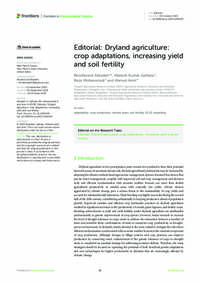Editorial: Dryland agriculture: crop adaptations, increasing yield and soil fertility

Authors:
Dryland agriculture in low precipitation areas remain low productive than their potential harvest because of uncertain climate risk, dryland agricultural productivity may be increased by adopting the climate-resilient based agronomic management options. Research has shown that precise water management, coupled with improved soil and crop management and decision tools and efficient mechanization with accurate weather forecast can more than double agricultural productivity in rainfed areas with currently low yields. Abiotic stresses aggravated by climate change pose a serious threat to the sustainability of crop yields and account for substantial yield reductions. Plant breeding was highly successful during the second half of the 20th century, contributing substantially to keeping production ahead of population growth. Improved varieties and efficient crop husbandry practices in dryland agriculture resulted in significant increases in the productivity of cereals, grain legumes, and fodder crops. Breeding achievements in yield and yield stability under dryland agriculture are attributable predominately to genetic improvement of crop species. However, future research to increase the level of drought tolerance in crops needs to address the interaction between a number of traits and assemble those combinations of traits to maximize crop productivity in drought-prone environments. In drylands, timely decision is the most critical to mitigate the risk where efficient mechanization synchronized with accurate weather forecast is the essential component of crop production. Although changes in tillage systems and crop practices can improve production by conserving water, enhancement of the genetic tolerance of crops to drought stress is considered an essential strategy for addressing moisture deficits. Therefore, the main strategies should be focused on capturing the potential of both beneficial genetic adaptations and new technologies for higher productivity in drylands that are increasingly affected by climate change.
